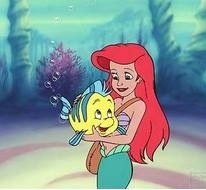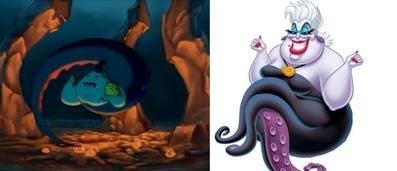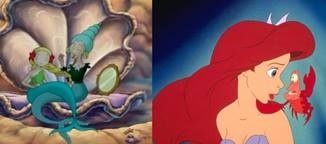|
By Dieuwertje - @Diejj Among all of the Once Upon A Time teasers during this year's San Diego Comic Con, the most exciting for myself and others was the video in which a certain someone stole Grumpy's fork - or should I say 'dinglehopper'? After which, a green tale and long red hair could be seen in the water. To anyone who knows their fairy tales (and Disney especially) - that could mean only one thing: Ariel is coming! Which leaves me with the question: what will she be like? We have learned from previous characters that the 'Once' writers tend to go with a mix of the original tale and the Disney interpretation - if an equivalent is available. This led me to take a look at the original little mermaid stacked up against Disney's Ariel, hoping that I would find some clues to the impending 'Once Upon A Time' Ariel. The average person on the street would probably think of dancing crabs, fish and a mischievous red head if I were to say 'The Little Mermaid' and we have the Disney Corporation to thank for that faux image. "The Little Mermaid" written by Hans Christian Andersen in 1836 is far from the happy ending of the Disney story and there is not one dancing or singing crab in the entire story. The original story tells of six mermaids, daughters of the Sea King. They are all beautiful yet the youngest of them – who remains without a name throughout the entire story – is the most beautiful of them all. Because the Sea King is widowed, it is their grandmother who takes care of them. She tells the mermaids stories about what life above the sea is like, for the mermaids are not allowed to rise up from the water to see for themselves before their fifteenth birthdays. The little mermaid is described as ‘quiet’ and ‘thoughtful’ and although there is no one who longs more to see what is above the water than she is, she patiently awaits the day that she will turn fifteen. It is only when she has turned fifteen and she is allowed to go up, that her love for human beings develops. She then falls in love with a prince she saves from drowning. She brings him to the beach after which a young girl takes further care of him. When the prince awakes he thinks it is this girl who saved him.  First of all, it is interesting to see how Disney changed some of the characters of the original story. In Andersen’s story the grandmother has quite a prominent role in the story. She is displayed as a wise old woman who raises the six mermaids. She knows all about life above the sea and tells this to her granddaughters, who all love, adore and respect her very much. Of course, it is the obvious choice to incorporate this character into the Disney movie transforming the wise respected grandmother into a small, male hothead of a Caribbean crab whose biggest quality is his talent for music – Oh, it’s not? Well, to Disney it apparently was. Andersen also pays attention to the bond the little mermaid has with her sisters. The story shows you how close all six sisters are. They really care for each other and this is all the more proven when the five older sisters cut their hair and go to the feared Sea Witch. To Disney, this family dynamic was apparently not interesting enough, so apart from their names, we know close to nothing about Ariel`s sisters. It seems that Ariel is not too close with them either. Instead, this part of the story is replaced by the character Flounder, a young male fish who has such a lack of courage that would make our beloved pre-Dark-One-Rumpelstiltskin appear courageous. By introducing Flounder, Disney gave our beloved Ariel the ultimate opportunity to express all her maternal feelings to the fullest. This brings us to Ariel’s character in general. You can say a lot about this redhead, but ‘quiet and thoughtful’ she is most definitely not. Ariel is disobedient; she disregards rules, and shows little respect to authority. She’s mischievous, yet has a big heart that accepts all and she is dedicated to what she believes in. The only traits the two mermaids have in common are their curiosity and desire to learn more about unknown things. One could say that Ariel’s character would be liked by feminists for the exact reason that she fights for her dreams. Yet when you look at it from another point of view, Ariel doesn’t seem to be so bad ass at all. After all, she sacrifices her voice – her right to speak, her right to be heard – so she can be with a man, a man whom she has to seduce therefore with her looks? According to Grandma Sebastian, that will work just fine, according to the little crab a woman is for the man to take, a verbal consent is not necessary, or so he sings in ´Kiss the Girl’: There you see her Sitting there across the way She don’t got a lot to say But there’s something about her And you don’t know why But you’re dying to try You wanna kiss the girl Yes, you want her Look at her, you know you do It’s possible she wants you, too There is one way to ask her It don’t take a word Not a single word Go on and kiss the girl Also, when things are going wrong, and Ursula seems to win, Ariel does not live up to her courageous nature at all; she willingly lets her father suffer for her, and so breaks the contract. Triton has a much more prominent role in the Disney movie to begin with. He in a way takes the place in the story of the grandmother, as the respected powerful ruler of the seven seas. In this way the Sea World seems to have become more of a patriarchy under Disney’s touch than the matriarchy that it was in Andersen’s fairytale. All feminine aspects of any importance are aborted or changed into male characters. The ocean and mermaids are female, and in Andersen’s story the Sea Witch – who is of course female too – is made hideous and appalling, as to keep the female image pure and associated with positive thoughts. However, in the Disney movie it is practically the other way around: Apart from our feminine ocean, Ariel is surrounded by male characters. The only other female character of importance is Ursula, the Sea Witch. She is still fat and evil, yet not so very disgusting anymore, she’s being transformed into a voluptuous creature that is elegant in an octopus kind of way. She embodies pure evil and in this way the image of the female who is not quiet, calm, graceful, and pure is connected to negative feelings. The mermaid can’t get the prince out of her head and asks her grandmother for more stories about the humans. Her grandmother tells her that although human beings die sooner than mermaids – who can live for 300 years sometimes – they have an immortal soul that ‘rises up through the clear, pure air beyond the glittering stars...to unknown and glorious regions which we shall never see”. After hearing this, the mermaid is determined to obtain an immortal soul. The only way to do this is by marrying a human being. And so, the little mermaid decides to turn to the only person who can help her with this: The Sea Witch. The witch is all too happy to help the young mermaid and says she will make a draught that will give her a pair of legs instead of a tail. However she warns the mermaid, telling her that she will feel great pain, and that every step will feel as if she were walking on sharp knives and if the prince does not choose her, she will become the foam that floats on the sea. The mermaid tells the witch that she will carry those burdens happily if it means she will have legs. Not even the payment for the draught can change the mermaid’s mind, and so the witch cuts out the tongue of the young mermaid, so she cannot speak or sing anymore. The Sea Witch tells her that she will simply have to seduce the prince using her expressive eyes, beauty and graceful dancing. When the mermaid reaches land she is found by the prince. He instantly takes a liking to her, however not in the way the girl had wanted. He doesn’t see her as a potential wife; instead she is a curiosity to him, whom he loves like a sister. When the time comes for the prince to marry, he does not choose the mermaid but the girl he thinks saved his life. This means the mermaid will die and become foam but then her sisters appear, their long hair cut off. They tell their little sister they sold their hair to the Sea Witch in exchange for a knife that will save the young mermaid from dying if she kills the prince with it. The mermaid accepts the knife, but in the end is not able to kill the prince, after which she throws herself into the sea expecting to die and become foam. However the mermaid does not become foam, for she is allowed to join the sisters of the air, who are given the chance to redeem themselves and obtain an immortal soul after all after 300 years of service. For every child that smiles they have to wait a year less, however for every crying child a year is added to their time. And so ends the story. And they lived not so happily ever after It is quite obvious that Walt Disney’s The Little Mermaid knows a happier ending. Therefore I feel no need to explain in depth how our Little Mermaid does not find a world where she is accepted like a woman and human being the way Ariel does. However, there are more subtle differences I find more interesting than the more obvious, surface differences. The Andersen story appears to be the nightmare of every feminist. Fairytales were originally meant to teach us a lesson, and what “The Little Mermaid” basically tells us is: A woman needs to be silent and beautiful and it is only through her marriage with a man that she can go to heaven. However, seeing that this fairytale was written in 1836, this is not really a surprise. What is a surprise though, is the way in which women are discredited in the Disney movie of 1989. At that point there had already been two waves of feminism and the third wave would occur a year after the movie was released. You would expect Disney to have ‘updated’ its view on women since Snow White and the Seven Dwarfs (1946). However, we would be wrong. Don’t get me wrong, I absolutely love Disney’s The Little Mermaid, it was one of my favourite Disney films when I grew up, and it still is. Yet it is remarkable in what way Walt Disney has adapted the original story. However, as to the question what our Once Upon A Time Ariel will be like, I don’t really think we will have to be afraid of any antifeminism. I would say all female characters in the show got their fair share of girl power, from Snow White to Regina to the fairy, Nova, none of them seem to be helpless damsels in distress. So rest assured, whatever interpretation the writers go with, I am sure we all are going to love Ariel. Let’s just hope they won’t go with walking on knives, or the lack of tongue, for that seems rather painful to me.
Works Cited: Andersen, Hans Christian, The Little Mermaid, http://hca.gilead.org.il/li_merma.html Bibliography: Bendix, Regina, ‘Seashell Bra and Happy End’, Fabula, 34.3-4 (2009), p. 280-290.
0 Comments
Leave a Reply. |
OriginsExplore the Arthurian legend surrounding Lancelot, take a trip into the woods to discover the mythology behind Red Riding Hood or learn more about a modern day hero called Snow White. Origins provides unique insights and perspectives from talented writers into the characters we know and love, going far beyond the boundaries of Storybrooke. Archives
August 2016
Categories
All
|


